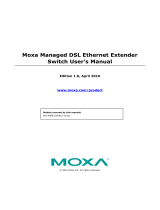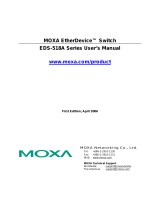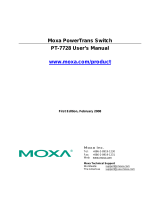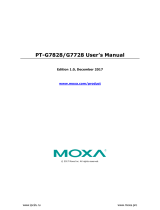Page is loading ...

PT-7528 Series User’s Manual
Edition 3.1, October 2017
www.moxa.com/product
© 2017 Moxa Inc. All rights reserved.

PT-7528 Series User’s Manual
The software described in this manual is furnished under a license agreement and may be used only in accordance with
the terms of that agreement.
Copyright Notice
© 2017 Moxa Inc., All rights reserved.
Trademarks
The MOXA logo is a registered trademark of Moxa Inc.
All other trademarks or registered marks in this manual belong to their respective manufacturers.
Disclaimer
Information in this document is subject to change without notice and does not represent a commitment on the part of
Moxa.
Moxa provides this document as is, without warranty of any kind, either expressed or implied, including, but not limited
to, its particular purpose. Moxa reserves the right to make improvements and/or changes to this manual, or to the
products and/or the programs described in this manual, at any time.
Information provided in this manual is intended to be accurate and reliable. However, Moxa assumes no responsibility for
its use, or for any infringements on the rights of third parties that may result from its use.
This product might include unintentional technical or typographical errors. Changes are periodically made to the
information herein to correct such errors, and these changes are incorporated into new editions of the publication.
Technical Support Contact Information
www.moxa.com/support
Moxa Americas
Toll
-free: 1-888-669-2872
Tel:
+1-714-528-6777
Fax:
+1-714-528-6778
Moxa China (Shanghai office)
Toll
-free: 800-820-5036
Tel:
+86-21-5258-9955
Fax:
+86-21-5258-5505
Moxa Europe
Tel:
+49-89-3 70 03 99-0
Fax:
+49-89-3 70 03 99-99
M
oxa Asia-Pacific
Tel:
+886-2-8919-1230
Fax:
+886-2-8919-1231
Moxa India
Tel:
+91-80-4172-9088
Fax:
+91-80-4132-1045

Table of Contents
1. About this Manual ............................................................................................................................. 1-1
2. Getting Started.................................................................................................................................. 2-1
USB Console Configuration (115200, None, 8, 1, VT100) ......................................................................... 2-2
Configuration by Command Line Interface (CLI) ..................................................................................... 2-5
Configuration by Web Browser ............................................................................................................. 2-7
Disabling Telnet and Browser Access ..................................................................................................... 2-8
3. Quick Settings ................................................................................................................................... 3-1
Quick Settings .................................................................................................................................... 3-2
System Time .............................................................................................................................. 3-2
IEC 61850 QoS ........................................................................................................................... 3-3
Redundancy ................................................................................................................................ 3-4
VLAN ......................................................................................................................................... 3-4
Mirror ........................................................................................................................................ 3-6
IP .............................................................................................................................................. 3-7
Summary .......................................................................................................................................... 3-8
Finish ................................................................................................................................................ 3-8
4. Advanced Settings............................................................................................................................. 4-1
Configuring Advanced Settings ............................................................................................................. 4-2
System Identification ................................................................................................................... 4-2
Password.................................................................................................................................... 4-3
Accessible IP List ......................................................................................................................... 4-4
Port Settings ............................................................................................................................... 4-5
Network Parameters .................................................................................................................... 4-6
GARP Timer Parameters ............................................................................................................... 4-8
System Time Settings .................................................................................................................. 4-9
IEEE 1588 PTP .......................................................................................................................... 4-10
System File Update .................................................................................................................... 4-15
Restart ..................................................................................................................................... 4-17
Reset to Factory Default ............................................................................................................. 4-17
Loop Protection ................................................................................................................................ 4-17
Using Port Trunking .......................................................................................................................... 4-18
The Port Trunking Concept ......................................................................................................... 4-18
Port Trunking Settings ............................................................................................................... 4-18
Configuring SNMP ............................................................................................................................. 4-20
SNMP Read/Write Settings .......................................................................................................... 4-21
Trap Settings ............................................................................................................................ 4-22
Private MIB Information ............................................................................................................. 4-23
Using Traffic Prioritization .................................................................................................................. 4-23
The Traffic Prioritization Concept ................................................................................................. 4-23
Configuring Traffic Prioritization .................................................................................................. 4-25
QoS ......................................................................................................................................... 4-25
Using Virtual LAN .............................................................................................................................. 4-28
The Virtual LAN (VLAN) Concept .................................................................................................. 4-28
Sample Applications of VLANs Using Moxa Switches ....................................................................... 4-30
Configuring Virtual LAN .............................................................................................................. 4-31
QinQ Setting ............................................................................................................................. 4-33
VLAN Table ............................................................................................................................... 4-34
Using Multicast Filtering ..................................................................................................................... 4-35
The Concept of Multicast Filtering ................................................................................................ 4-35
Configuring IGMP Snooping ........................................................................................................ 4-38
Current Active IGMP Streams ...................................................................................................... 4-40
Static Multicast MAC Addresses ................................................................................................... 4-41
Configuring GMRP...................................................................................................................... 4-42
GMRP Table .............................................................................................................................. 4-42
Multicast Filtering Behavior ......................................................................................................... 4-43
Using Bandwidth Management ............................................................................................................ 4-43
Configuring Bandwidth Management ............................................................................................ 4-43
Security ........................................................................................................................................... 4-45
User Login Authentication – User Login Settings ............................................................................ 4-45
User Login Authentication – Auth Server Setting ........................................................................... 4-46
Authentication Certificate ................................................................................................................... 4-46
Using Port Access Control .................................................................................................................. 4-47
Static Port Lock ......................................................................................................................... 4-47
IEEE 802.1X ............................................................................................................................. 4-47
Configuring Static Port Lock ........................................................................................................ 4-47
Configuring IEEE 802.1X ............................................................................................................ 4-48
Using Auto Warning .......................................................................................................................... 4-50

Configuring Email Warning ......................................................................................................... 4-50
Configuring Relay Warning ......................................................................................................... 4-53
Using Line-Swap-Fast-Recovery .......................................................................................................... 4-54
Configuring Line-Swap Fast Recovery .......................................................................................... 4-55
Using Set Device IP ........................................................................................................................... 4-55
Configuring Set Device IP ........................................................................................................... 4-56
Using Diagnosis ................................................................................................................................ 4-58
Mirror Port ................................................................................................................................ 4-58
Ping ......................................................................................................................................... 4-59
LLDP Function ........................................................................................................................... 4-59
Using Monitor ................................................................................................................................... 4-60
Monitor by Switch ...................................................................................................................... 4-60
Monitor by Port ......................................................................................................................... 4-61
Fiber Digital Diagnostics Monitoring (SFP DDM and Fiber Check) ..................................................... 4-61
Fiber Check .............................................................................................................................. 4-62
Using the MAC Address Table ............................................................................................................. 4-64
Using Access Control List ................................................................................................................... 4-64
The ACL Concept ....................................................................................................................... 4-64
Access Control List Configuration and Setup ................................................................................. 4-66
Using Event Log ............................................................................................................................... 4-70
Using Syslog .................................................................................................................................... 4-71
Using HTTPS/SSL .............................................................................................................................. 4-71
Using Industrial Protocol .................................................................................................................... 4-72
EtherNet/IP .............................................................................................................................. 4-72
Modbus/TCP ............................................................................................................................. 4-72
MMS ........................................................................................................................................ 4-73
5. EDS Configurator GUI ........................................................................................................................ 5-1
Starting EDS Configurator .................................................................................................................... 5-2
Broadcast Search ................................................................................................................................ 5-2
Search by IP Address .......................................................................................................................... 5-3
Upgrade Firmware .............................................................................................................................. 5-3
Modify IP Address ............................................................................................................................... 5-4
Export Configuration ........................................................................................................................... 5-4
Import Configuration ........................................................................................................................... 5-5
Unlock Server .................................................................................................................................... 5-6
A. MIB Groups ....................................................................................................................................... A-1

1
1. About this Manual
Thank you for purchasing a Moxa managed Ethernet switch. Read this user’s manual to learn how to connect
your Moxa switch to Ethernet-enabled devices used for industrial applications.
The following two chapters are covered in this user manual:
Chapter 2: Getting Started
This chapter explains the initial installation process for a Moxa switch. There are three ways to access a
Moxa switch’s configuration settings: serial console, Telnet console, and web console.
Chapter 3: Featured Functions
This chapter explains how to access a Moxa switch’s various configuration, monitoring, and administration
functions. These functions can be accessed by serial, Telnet, or web console. The web console is the most
user-friendly way to configure a Moxa switch. In this chapter, we use the web console interface to introduce
the functions.

2
2. Getting Started
In this chapter we explain how to install a Moxa switch for the first time. There are three ways to access the
Moxa switch’s configuration settings: serial console, Telnet console, or web console. If you do not know the
Moxa switch’s IP address, you can open the serial console by connecting the Moxa switch to a PC’s COM port
with a short serial cable. You can open the Telnet or web console over an Ethernet LAN or over the Internet.
The following topics are covered in this chapter:
USB Console Configuration (115200, None, 8, 1, VT100)
Configuration by Command Line Interface (CLI)
Configuration by Web Browser
Disabling Telnet and Browser Access

PT-7528 Series Getting Started
2-2
USB Console Configuration (115200, None, 8, 1,
VT100)
NOTE
•
You cannot connect to the USB console and command line interface at the same time.
•
You can connect to the web console and another console (serial or Telnet) at the same time. However
, we
strongly recommend that you do NOT do so. Following this advice will allow you to maintain better control
over the Moxa switch’s configuration.
NOTE
We recommend
using PComm Terminal Emulator when opening the USB console. This software can be
downloaded free of charge from the Moxa website.
Before running PComm Terminal Emulator, first install the USB console driver on your PC and then connect the
Moxa switch’s USB console port to your PC’s USB port with a USB cable.
After installing PComm Terminal Emulator, open the Moxa switch’s USB console as follows:
1. From the Windows desktop, click Start > Moxa > PComm Lite Ver1.6 > Terminal Emulator.
2. Select Open under the Port Manager menu to open a new connection.

PT-7528 Series Getting Started
2-3
3. The Property window should open. On the Communication Parameter tab for Ports, select the COM
port that is being used for the console connection. Set the other fields as follows: 115200 for Baud Rate,
8 for Data Bits, None for Parity, and 1 for Stop Bits.
4. On the Terminal tab, select VT100 for Terminal Type, and then click OK to continue.
5. In the terminal window, the Moxa switch will prompt you to select a terminal type. Enter 1 to select
ansi/vt100 and then press Enter.

PT-7528 Series Getting Started
2-4
6. The USB console will prompt you to log in. Press Enter and select admin or user. Use the down arrow key
on your keyboard to select the Password field and enter a password if desired. This password will be
required to access any of the consoles (web, serial, Telnet).
NOTE
By default, the
password assigned to the Moxa switch is moxa. Be sure to
change the default password after
you first
log in to help keep your system secure.
7. The Main Menu of the Moxa switch’s USB console should appear. (In PComm Terminal Emulator, you can
adjust the font by selecting Font… from the Edit menu.)
8. Use the following keys on your keyboard to navigate the Moxa switch’s USB console:
Key Function
Up, down, right, left arrow keys, Tab Move the onscreen cursor
Enter Display and select options
Space Toggle options
Esc Previous menu

PT-7528 Series Getting Started
2-5
Configuration by Command Line Interface (CLI)
Opening the Moxa switch’s Telnet or web console over a network requires that the PC host and Moxa switch are
on the same logical subnet. You may need to adjust your PC host’s IP address and subnet mask. By default, the
Moxa switch’s IP address is 192.168.127.253 and the Moxa switch’s subnet mask is 255.255.255.0 (referred to
as a Class B network). Your PC’s IP address must be set to 192.168.xxx.xxx if the subnet mask is 255.255.0.0,
or to 192.168.127.xxx if the subnet mask is 255.255.255.0.
NOTE
To connect to the Moxa switch’s Telnet or web console, your PC host and the Moxa switch must be on the same
logical subnet.
NOTE
When connecting to the Moxa switch’s Telnet or web console, first connect one of the Moxa switch’s Ethernet
ports to your Ethernet LAN, or directly to your PC’s Ethernet port. You may use either a straight
-
through or
cross
-over Ethernet cable.
NOTE
The Moxa switch’s default IP address is 192.168.127.253.
After making sure that the Moxa switch is connected to the same LAN and logical subnet as your PC, open the
Moxa switch’s Telnet console as follows:
1. Click Start
Run from the Windows Start menu and then Telnet to the Moxa switch’s IP address from the
Windows Run window. You may also issue the Telnet command from a DOS prompt.
2. In the terminal window, the Telnet console will prompt you to select a terminal type. Type 1 to choose
ansi/vt100, and then press Enter.

PT-7528 Series Getting Started
2-6
3. The Telnet console will prompt you to log in. Press Enter and then select admin or user. Use the down
arrow key on your keyboard to select the Password field and enter a password if desired. This password
will be required to access any of the consoles (web, serial, Telnet). If you do not wish to create a password,
leave the Password field blank and press Enter.
4. The Main Menu of the Moxa switch’s Telnet console should appear.
5. In the terminal window, select Preferences… from the Terminal menu on the menu bar.
6. The Terminal Preferences window should appear. Make sure that VT100 Arrows is checked.

PT-7528 Series Getting Started
2-7
7. Use the following keys on your keyboard to navigate the Moxa switch’s Telnet console:
Key Function
Up, down, right, left arrow keys, Tab Move the onscreen cursor
Enter Display and select options
Space Toggle options
Esc Previous menu
NOTE
The Telnet console looks
and operates in precisely the same manner as the USB console.
Configuration by Web Browser
The Moxa switch’s web console is a convenient platform for modifying the configuration and accessing the
built-in monitoring and network administration functions. You can open the Moxa switch’s web console using a
standard web browser, such as Internet Explorer.
NOTE
To connect to the Moxa switch’s Telnet or web console, your PC host and the Moxa switch must be on the same
logical subnet.
NOTE
If the Moxa switch
is configured for other VLAN settings, you must make sure your PC host is on the
management VLAN.
NOTE
When connecting to the Moxa switch’s Telnet or web console, first connect one of the Moxa switch’s Ethernet
ports to your Ethernet LAN, or directly to
your PC’s Ethernet port. You may use either a straight-
through or
cross
-over Ethernet cable.
NOTE
The Moxa switch’s default IP address is 192.168.127.253.
After making sure that the Moxa switch is connected to the same LAN and logical subnet as your PC, open the
Moxa switch’s web console as follows:
1. Connect your web browser to the Moxa switch’s IP address by entering it in the Address or URL field.
2. The Moxa switch’s web console will open, and you will be prompted to log in. Select the login account
(admin or user) and enter the Password. This password will be required to access any of the consoles (web,
serial, Telnet). If you do not wish to create a password, leave the Password field blank and press Enter.

PT-7528 Series Getting Started
2-8
NOTE
By default, no password is assigned
to the Moxa switch’s web, serial, and Telnet consoles.
3. After logging in, you may need to wait a few moments for the web console to appear and select the setting
mode.
Disabling Telnet and Browser Access
If you are connecting the Moxa switch to a public network but do not intend to manage it over the network, we
suggest disabling both the Telnet and web consoles. This is done from the serial console by navigating to
System Identification under Basic Settings. Disable or enable the Telnet Console and Web
Configuration as shown below:

3
3. Quick Settings
In this chapter, we explain how to easily set the Moxa PowerTrans Series switch’s configuration for substation
users. You can configure the main functions step by step. These functions can be accessed by web console. The
web console is the most user-friendly interface for configuring a Moxa switch and can be opened over an
Ethernet LAN or the Internet.
The following topics are covered in this chapter:
Quick Settings
System Time
IEC 61850 QoS
Redundancy
VLAN
Mirror
IP
Summary
Finish

PT-7528 Series Quick Settings
3-2
Quick Settings
The Quick Settings section includes the most common settings required by administrators to maintain and
control a Moxa PowerTrans Series switch.
System Time
The Moxa switch has a time calibration function based on information from an NTP server or user specified time
and date. Functions such as automatic warning emails can therefore include time and date stamp.
NOTE
The Moxa switch does not have a real time clock. The user must update the Current Time and Current Date
to set the initial time for the Moxa switch after each reboot, especially when there is no NTP server on the LAN
or Internet connection.
Current Time
Setting Description Factory Default
User-specified time Allows configuration of the local time in local 24-hour format. None
Current Date
Setting Description Factory Default
User-specified date Allows configuration of the local date in yyyy-mm-dd format. None
Time Server IP/Name
Setting Description Factory Default
IP address or name of
time server
The IP or domain address (e.g., 192.168.1.1,
time.stdtime.gov.tw, or time.nist.gov).
None
IP address or name of
secondary time server
The Moxa switch will try to locate the secondary NTP server if
the first NTP server fails to connect.
Time Protocol
Setting Description Factory Default
Disable Disables SNTP/NTP server functionality for clients -
NTP NTP (Network Time Protocol) is used to synchronize time with
multiple time servers. The time accuracy is up to 50 ms.
-
SNTP SNTP stands for (Simple Network Time Protocol). The
synchronization process of SNTP is simpler than NTP. The time
accuracy is up to 1 second, which is suitable for low time
accuracy requirements.
-

PT-7528 Series Quick Settings
3-3
IEC 61850 QoS
The Moxa PowerTrans Series switch provides IEC 61850 Quality of Service (QoS). Once you enable IEC
61850 QoS, the packet priority of GOOSE/SMV/PTP is higher than other packets’ type.
Enable Packet Priority
Setting Description Factory Default
Enable IEC 61850 QoS Enables or disables IEC 61850 OoS function. disables
GOOSE
Setting Description Factory Default
High/Medium/Normal/
Low
The priority sequence is High>Medium>Normal>Low. We
recommend setting GOOSE packet as high priority.
High
SMV
Setting Description Factory Default
High/Medium/Normal/
Low
The priority sequence is High>Medium>Normal>Low. We
recommend setting SMV packet as high priority.
High
PTP
Setting Description Factory Default
High/Medium/Normal/
Low
The priority sequence is High>Medium>Normal>Low. High

PT-7528 Series Quick Settings
3-4
Redundancy
The Moxa switch uses an IP address-based filtering method to control access.
Redundancy Protocol
Setting Description Factory Default
None Ring redundancy is not active. None
RSTP Select this item to change to the RSTP configuration page.
Turbo Ring V2 Select this item to change to the Turbo Ring V2 configuration
page.
Redundant Port
Setting Description Factory Default
1
st
Port Select any port of the switch to be one of the redundant ports.
27, 28
2
nd
Port Select any port of the switch to be one of the redundant ports.
You can set other redundancy protocols, such as Turbo Ring V1/Turbo Chain/MSTP, in advanced setting section.
More details please refer to “Communication Redundancy User’s Manual”.
VLAN
To configure 802.1Q VLAN and port-based VLANs on the Moxa switch, use the VLAN Settings page to
configure the ports.
VLAN Mode
Setting Description Factory Default
802.1Q VLAN Set VLAN mode to 802.1Q VLAN 802.1Q VLAN
Unaware VLAN Set VLAN mode to Unaware VLAN

PT-7528 Series Quick Settings
3-5
802.1Q VLAN Settings
Port
Setting Description Factory Default
Port from 1 to 28 Assigns port number. ---
Port Type
Setting Description Factory Default
Access Port type is used to connect single devices without tags. Access
Trunk Select Trunk port type to connect another 802.1Q
VLAN aware
switch
Hybrid Select Hybrid port to connect another Access 802.1Q VLAN
aware switch or another LAN that combines tagged and/or
untagged devices and/or other switches/hubs.
ATTENTION
For communication redundancy in the VLAN environment, set
Redundant Port Coupling Port and
Coupling Control Port
as Trunk Port since these ports act as the backbone to transmit all packets of
different VLANs to different Moxa switch units.
Port PVID
Setting Description Factory Default
VID ranges from 1 to
4094
Sets the default VLAN ID for untagged devices that connect to
the port.
1

PT-7528 Series Quick Settings
3-6
Fixed VLAN List (Tagged)
Setting Description Factory Default
VID ranges from 1 to
4094
This field will be active only
when selecting the Trunk or Hybrid
port type. Set the other VLAN ID for tagged devices that
connect to the port. Use commas to separate different VIDs.
None
Unaware VLAN Settings
The Unaware VLAN function provides users a flexible operation in a VLAN network. Switches which are set on
Unaware VLAN mode do not check the VLAN tags of input Ethernet frame. All of VLAN tags can always in and
out of the Unaware VLAN switch, and the switch won’t affect the VLAN tags of Ethernet frames.
More details about VLAN concept please refer to “Advanced Settings - Using Virtual LAN”.
Mirror
The Mirror function can be used to monitor data being transmitted through a specific port. This is done by
setting up another port (the mirror port) to receive the same data being transmitted from, or both to and from,
the port under observation. Using a mirror port allows the network administrator to sniff the observed port to
keep tabs on network activity.

PT-7528 Series Quick Settings
3-7
Mirror Port Settings
Setting Description
Monitored Port Select the number of the ports whose network activity will be monitored.
Mirror Port
Select the number of the port that will be used to monitor the activity of the monitored
port.
IP
The IPv4 settings include the switch’s IP address and subnet mask, as well as the IP address of the default
gateway.
IP Configuration
Setting Description Factory Default
DHCP
The Moxa switch’s IP address will be assigned automatically by
the network’s DHCP server.
Static The Moxa switch’s IP address will be assigned by inputting.
Switch IP Address
Setting Description Factory Default
IP address for the Moxa
switch
Assigns the Moxa switch’s IP address on a TCP/IP network. 192.168.127.253
Switch Subnet Mask
Setting Description Factory Default
Subnet mask for the
Moxa switch
Identifies the type of network the Moxa switch is connected to
(e.g., 255.255.0.0 for a Class B network, or 255.255.255.0 for
a Class C network).
255.255.255.0
Default Gateway
Setting Description Factory Default
IP address for gateway
Specifies the IP address of the router that connects the LAN to
an outside network.
None
/




